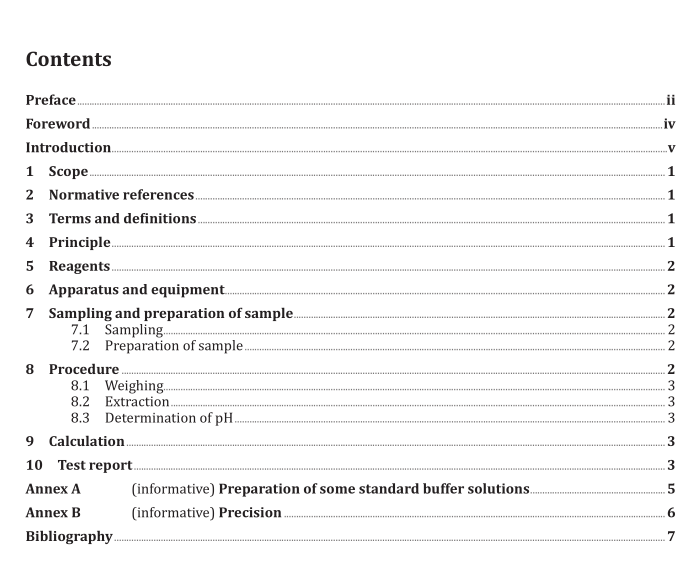AS NZS 1301.421 pdf download – Method of test for pulp and paper Method 421: Paper, board and pulps — Determination of pH of aqueous extracts — Cold extraction

AS NZS 1301.421 pdf download – Method of test for pulp and paper Method 421: Paper, board and pulps — Determination of pH of aqueous extracts — Cold extraction
5 Reagents
5.1 Water, distilled or deionised water shall be used throughout the test. The conductivity of the water shall not exceed 0,1 mS/m, after boiling for 1 h and cooling in an acid-free atmosphere (e.g. free of CO 2 , SO 2 , H 2 S) to a temperature between 20 °C and 25 °C. The pH of the water should be in the range of 6,8 to 7,3. Instructions for the determination of conductivity are specified in ISO 3696.
5.2 Standard buffer solutions, with known pH-values of about 4, 7 and 9. Such buffer solutions are commercially available. Some examples of suitable buffer solutions are given, and their preparation is described, in Annex A.
5.3 Potassium chloride solution, 1M. Dissolve 7,4 g of KCl, analytical grade, into 100 ml of freshly boiled, distilled water. Prepare a fresh solution every week. 6 Apparatus and equipment Use the following, in addition to ordinary laboratory apparatus and equipment.
6.1 Glassware of chemically resistant glass, flasks with ground-glass joints, stoppers, beakers and fritted glass filter. All glassware shall be cleaned with an acid cleaning solution, without the use of soap or detergent, and they shall be carefully rinsed with water (5.1) and allowed to dry before use.
6.2 pH-meter, fitted with glass and calomel electrodes or with a combined electrode, capable of being read to at least 0,05 pH-unit.
7 Sampling and preparation of sample
7.1 Sampling The sampling procedure to be followed depends on the particular circumstances in each case. If the analysis is being made to evaluate a lot or a consignment of pulp, paper or board, the sample shall be taken in accordance with ISO 7213 or ISO 186, as relevant. If the analysis is made on another type of sample, report the origin of the sample and, if possible, the sampling procedure, and ensure that the specimen taken in 7.1 is representative of the sample received. Wear clean protective gloves when handling the sample. NOTE Some gloves are powdered to prevent them from sticking to one another, and this powder can cause contamination of the sample.
7.2 Preparation of sample Do not touch the sample with bare hands and ensure that it has been placed only on clean surfaces. Cut the sample with a knife or cutter, or tear it, into pieces approximately 1 cm 2 in size. Split samples of heavy board. Mix the pieces thoroughly. Store the pieces in clean, covered containers.
8 Procedure Run the procedure in duplicate.
8.1 Weighing Weigh 2,0 g ± 0,1 g of air-dry sample (6.2) in a 250 ml flask (5.1). NOTE Since the amount of sample is not critical, there is no need to determine the dry matter content to adjust for minor differences in moisture content.
8.2 Extraction Add 100 ml of water (5.1) to the flask (6.1) containing the sample pieces. Check that all pieces are soaked. Seal the flask with its ground-glass stopper and leave it to stand for 1 h at a temperature between 20 °C and 25 °C. Shake the flask at least once during this time. Filter the extract through a coarse, fritted glass filter into a small beaker (6.1). Immediately add 2 ml of potassium chloride solution (5.3) and continue with the measurement.
8.3 Determination of pH Operate the pH-meter in accordance with the manufacturer’s instruction. Wash the electrodes with water (5.1); allow the water to drain from the electrodes, but do not wipe them. Calibrate the pH-meter (5.2), at a temperature between 20 °C and 25 °C, with two different buffer solutions (5.2) having pHvalues such that the pH of the extract is between the pH-values of the buffer solutions. The first buffer solution shall be chosen so that the pH-value of the buffer solution is in the same region as the electric zero point of the pH-meter (usually = 7). The reading for the second buffer solution should agree with its correct value to within 0,1 pH-unit. If the pH-meter fails to show the correct pH-value for the second buffer solution, consult the manufacturer’s manual. A deviation of, or exceeding, 0,2 pH-units, rounded to the nearest 0,1 pH unit, indicates a faulty electrode. In addition, a slow but continuous increase or decrease in the reading indicates a faulty electrode.









